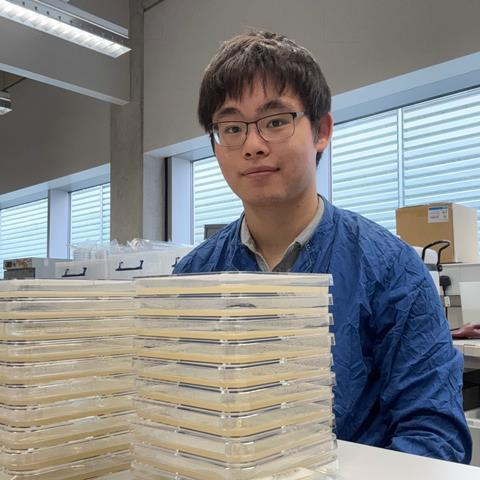Li Shen reports back on his AMI-sponsored summer studentship which investigated a novel antibiotic adjuvant at the Centre for Bacterial Resistance Biology, Imperial College London.
Shen (20), from Beijing, is studying BSc Medical Biosciences at Imperial College London and his studentship is based in Dr Andrew Edwards’ lab, alongside Dr Ed Douglas, who provides day-to-day supervision.

My work is investigating a novel antibiotic adjuvant, which permeabilises the outer membrane of drug-resistant Gram-negative bacteria. This permeabilisation makes the bacteria susceptible to antibiotics that would otherwise be ineffective.
I’ve learnt a range of new techniques and am applying them to various experiments. For example, I use minimum inhibitory concentration (MIC) and time-kill assays to measure antibiotic susceptibility, SYTOX Green to measure membrane-permeability and I’m about to learn how to measure bacterial LPS levels. Added to this, I’ve also learnt how to process, analyse and present the data I generate in the lab.
The Edwards lab focuses on understanding how antibiotics target bacteria, how this is affected by the host environment, and the development of novel therapeutic approaches to overcome antibiotic resistance and tolerance.
My project contributes to this goal by testing whether a novel peptide can destabilise the outer membrane of E. coli, thereby enhancing the activity of other antibiotics. If successful, this strategy could repurpose existing antibiotics that currently lack efficacy against Gram-negative bacteria, providing new treatment options in the face of rising antibiotic resistance.
New approaches needed
Antibiotic resistance poses a major threat to modern medicine, undermining advances in surgery, cancer chemotherapy, organ transplantation, and the survival of pre-term infants. Developing novel therapeutic strategies is essential to overcome this challenge.
New approaches are needed, but very few novel drugs are in the pipeline. Therefore, this approach seeks to find ways to use normally ineffective drugs. Membrane permeabilisers have the potential to make lots of different antibiotics work better, opening up the possibility of a range of new treatments from just one permeabiliser.
I’ve only been in the lab for a few weeks, but our early findings are promising. Working with the rest of the team, I discovered that the peptide synergises well with a range of different antibiotics.
Collaborative atmosphere
Something that really impressed me was how collaborative the lab is. Even though pretty much everyone is working on a different project, people take interest in each other’s work and are always willing to help out. For me, this supportive environment directly translated to a great working experience and high productivity - I was pleasantly surprised by how much meaningful data I was able to generate in such a short time.
Least favourite job in the lab? While almost all aspects of lab work are fascinating, filling up pipette tip boxes can become very dull :(
What are you going to do next? I’m going to do a placement at AstraZeneca in Cambridge as part of my degree. After I graduate, I would like to pursue a Masters and PhD. In the long term, I would like to keep contributing to the field of biomedical research, particularly on tackling infectious diseases and antimicrobial resistance.
Find out more about AMI’s grants.
Topics
- Andrew Edwards
- Antibiotics
- Antimicrobial Resistance
- Antimicrobials
- Applied Microbiology International
- AstraZeneca
- Bacteria
- biomedical
- Community
- Early Career Research
- Ed Douglas
- Gram-negative bacteria
- Imperial College London
- Li Shen
- One Health
- People News
- permeabilisation
- Pharmaceutical Microbiology
- UK & Rest of Europe







No comments yet